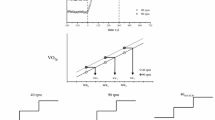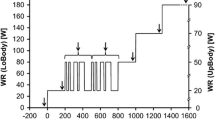Abstract
We have previously observed that following the onset of moderate intensity cycle ergometry, the pulmonary O2 uptake (V̇O2) in trained cyclists often does not increase towards its steady-state value with the typical mono-exponential characteristics; rather, there is a transient “overshoot”. The purpose of this study was to systematically examine this phenomenon by comparing the V̇O2responses to two moderate-intensity work rates and one high-intensity work rate in trained and untrained subjects. Following a ramp exercise test to the limit of tolerance for the determination of the gas exchange threshold (GET) and V̇O2peak, seven trained cyclists [mean (SD); V̇O2peak 66.6 (2.5) ml·kg−1·min−1] and eight sedentary subjects [V̇O2peak 42.9 (5.1) ml·kg−1·min−1] completed six step transitions from baseline cycling to work rates requiring 60% and 80% GET and three step transitions from baseline cycling to a work rate requiring 50% of the difference between GET and V̇O2peak (50%Δ). V̇O2 was measured breath-by-breath and modelled using standard techniques. The sedentary subjects did not overshoot the steady-state V̇O2 at any intensity. At 60% GET, six of the seven cyclists overshot the steady-state V̇O2 [by an integral volume of 164 (44) ml between ~45 and 125 s]. At 80% GET, four of the seven cyclists overshot the steady-state V̇O2 [by an integral volume of 185 (92) ml between ~55 and 140 s]. None of the cyclists showed an overshoot at 50%Δ. These results indicate that trained cyclists evidence an overshoot in V̇O2 before steady-state is reached in the transition to moderate-intensity exercise. The mechanism(s) responsible for this effect remains to be elucidated, as does whether the overshoot confers any functional or performance benefit to the trained cyclist.



Similar content being viewed by others
References
Aliverti A, Kayser B, Macklem PT (2004) Breath-by-breath assessment of alveolar gas stores and exchange. J Appl Physiol 96:1464–1469
Auchincloss JH, Gilbert R, Baule GH (1966) Effect of ventilation on oxygen transfer during early exercise. J Appl Physiol 21:810–818
Bangsbo J (1996) Physiological factors associated with efficiency in high intensity exercise. Sports Med 22:299–305
Barclay CJ (1996) Mechanical efficiency and fatigue of fast and slow muscles of the mouse. J Physiol (Lond) 497:781–794
Barstow TJ, Molé PA (1991) Linear and nonlinear characteristics of oxygen uptake kinetics during heavy exercise. J Appl Physiol 71:2099–2106
Barstow TJ, Lamarra N, Whipp BJ (1990) Modulation of muscle and pulmonary O2 uptakes by circulatory dynamics during exercise. J Appl Physiol 68:979–989
Boska M (1994) ATP production rates as a function of force level in the human gastrocnemius/soleus using 31P-MRS. Magn Reson Med 32:1–10
Burelle Y, Hochachka PW (2002) Endurance training induces muscle-specific changes in mitochondrial function in skinned muscle fibers. J Appl Physiol 92:2429–2438
Capelli C, Cautero M, di Prampero PE (2001) New perspectives in breath-by-breath determination of alveolar gas exchange in humans. Pflugers Arch 441:566–577
Casaburi R, Weissman ML, Huntsman DJ, Whipp BJ, Wasserman K (1979) Determinants of gas exchange kinetics during exercise in the dog. J Appl Physiol 46:1054–1060
Casaburi R, Spitzer S, Haskell R, Wasserman K (1989) Effect of altering heart rate on oxygen uptake at exercise onset. Chest 95:6–12
Cautero M, Beltrami AP, di Prampero PE, Capelli C (2002) Breath-by-breath alveolar oxygen transfer at the onset of step exercise in humans: methodological implications. Eur J Appl Physiol 88:203–213
Cautero M, di Prampero PE, Capelli C (2003) New acquisitions in the assessment of breath-by-breath alveolar gas transfer in humans. Eur J Appl Physiol 90:231–241
Corsi A, Granata AL, Midrio M, Turchetto M (1975) Observations upon the rate-limiting role of blood flow in the regulation of respiration of skeletal muscle during intermittent exercise. In: Howald H, Poortmans JR (eds) Metabolic adaptation to prolonged physical exercise. Birkhauser, Basel, pp 65–69
De Haan A, De Jong J, Van Doorn JE, Huijing PA, Woittiez RD, Westra HG (1986) Muscle economy of isometric contractions as a function of stimulation time and relative muscle length. Pflugers Arch 407:445–450
Di Prampero PE, Mahler PB, Giezendanner D, Cerretelli P (1989) Effects of priming exercise on V̇02 kinetics and O2 deficit at the onset of stepping and cycling. J Appl Physiol 66:2023–2031
Giannesini B, Izquierdo M, Le Fur Y, Cozzone PJ, Bendahan D (2001) In vivo reduction in ATP cost of contraction is not related to fatigue level in stimulated rat gastrocnemius muscle. J Physiol (Lond) 536:905–915
Grassi B, Gladden LB, Samaja M, Stary CM, Hogan MC (1998) Faster adjustment of O2 delivery does not affect V̇02 on-kinetics in isolated in situ canine muscle. J Appl Physiol 85:1394–1403
Grønlund L (1984) A new method for breath-to-breath determination of oxygen flux across the alveolar membrane. Eur J Appl Physiol 52:167–172
Hochachka PW, Burelle Y (2004) Control of maximum metabolic rate in humans: dependence on performance phenotypes. Mol Cell Biochem 256:95–103
Holloszy JO, Coyle EF (1984) Adaptations of skeletal muscle to endurance exercise and their metabolic consequences. J Appl Physiol 56:831–838
Linnarsson D (1990) The body as a bioenergetic system – lessons from systems engineering and comparative physiology. Med Sci Sports Exerc 22:59–61
Newcomer BR, Boska MD, Hetherington PH (1999) Non-P(i) buffer capacity and initial phosphocreatine breakdown and resynthesis kinetics of human gastrocnemius/soleus muscle groups using 0.5 s time-resolved 31P-MRS at 4.1 T. Nucl Magn Reson Med 12:545–551
Paterson DH, Whipp BJ (1991) Asymmetries of oxygen uptake transients at the on- and offset of heavy exercise in humans. J Physiol (Lond) 443:575–586
Phillips SM, Green HJ, Tarnopolsky MA, Heigenhauser GJ, Grant SM (1996) Progressive effect of endurance training on metabolic adaptations in working skeletal muscle. Am J Physiol Endocrinol Metab 270:E265–272
Rossiter HB, Ward SA, Doyle VL, Howe FA, Griffiths JR, Whipp BJ (1999) Inferences from pulmonary O2 uptake with respect to intramuscular (phosphocreatine) kinetics during moderate exercise in humans. J Physiol (Lond) 518:921–932
Rossiter HB, Ward SA, Kowalchuk JM, Howe FA, Griffiths JR, Whipp BJ (2002) Dynamic asymmetry of phosphocreatine concentration and O2 uptake between the on- and off-transients of moderate- and high-intensity exercise in humans. J Physiol (Lond) 541:991–1002
Whipp BJ, Mahler M (1980) Dynamics of gas exchange during exercise. In: West JB (ed) Pulmonary gas exchange vol II. Academic, New York, pp 33–96
Whipp BJ, Ward SA, Lamarra N, Davis JA, Wasserman K (1982) Parameters of ventilatory and gas exchange dynamics during exercise. J Appl Physiol 52:1506–1513
Acknowledgements
The authors would like to thank E. Bourgonjon, S. De Smet, E. De Vriendt and J. Gijsel for their participation in the pilot experiments and M. De Brie for her technical assistance. The authors declare that the experiments comply with the current laws of the country in which they were performed.
Author information
Authors and Affiliations
Corresponding author
Rights and permissions
About this article
Cite this article
Koppo, K., Whipp, B.J., Jones, A.M. et al. Overshoot in V̇O2 following the onset of moderate-intensity cycle exercise in trained cyclists. Eur J Appl Physiol 93, 366–373 (2004). https://doi.org/10.1007/s00421-004-1229-8
Accepted:
Published:
Issue Date:
DOI: https://doi.org/10.1007/s00421-004-1229-8




